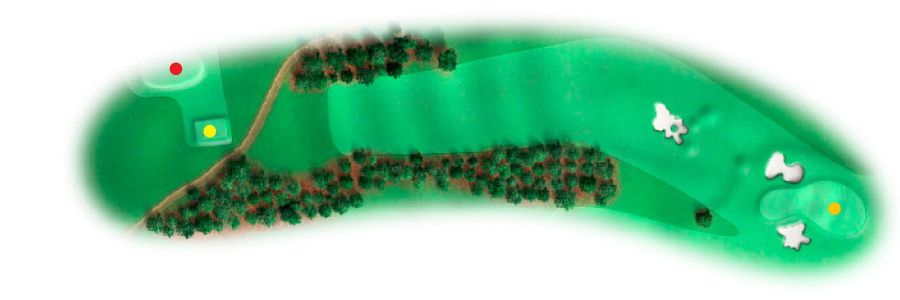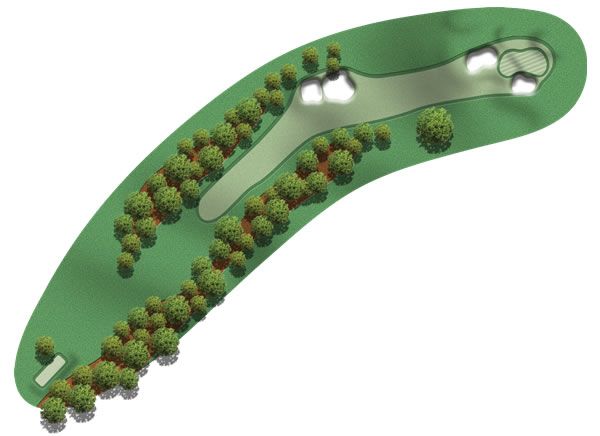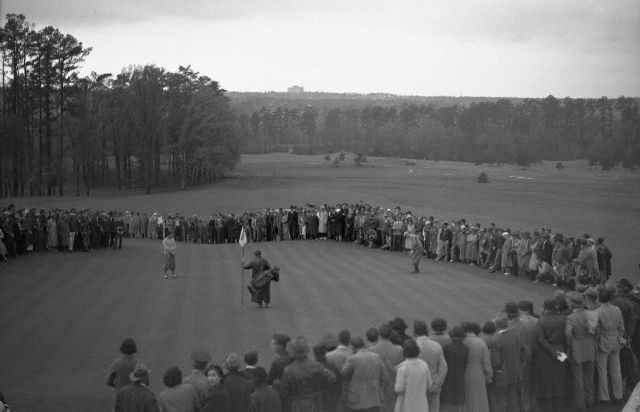Hole 18 - Holly - Par 4


1934 - 420 yards - The hole played 70 feet uphill, over a valley to a landing area about 25 feet higher, then another 45 feet up to the green. Whether the bunker right of MacKenzie's enormous stair-stepped green was deliberately shaped like the state of Texas has never been determined.
1938 - 425 yards - Like he did on the nearby 9th, Maxwell eliminated the long front tongue on the 18th green after the '37 Masters. MacKenzie's cross bunker remains a mystery. About 100 yards short of the green, it was too far off the tee to be a problem on drives but too far from the green to interfere with approaches. The bunker remained until 1956.
1947 - 425 yards - Standing on an "amphitheater mound" by the 18th at the '46 Masters, Jones watched Hogan 3-putt from 12 feet to lose by one. He said to Trent Jones "That's not fair. We've got to change that." Trent recontoured the green that summer. Recalling the putt years later, Hogan said, "The greens were so slick you could almost hear them crackle, which I liked."
1967 - 420 yards - Two summers after Nicklaus set a scoring record, two fairway bunkers were created. Roberts called them a "huge, two-sectioned bunker," probably because the club appropriated funds for only two bunkers, and Roberts also wanted one built on the 2nd. In the next Masters, Nicklaus caught the sand off the tee, made bogey and missed the cut by one shot.
1975 - 420 yards - Just a month before the '75 Masters - an unusual time to make alterations - Roberts had pine trees planted in a 75-yard gap between the existing tree line on the left and the fairway bunkers. "To provide a potential penalty for a duck-hooked tee shot," Roberts said. In 1978, Hogan wrote the club, advocating elimination of the fairway bunkers on 18, a request that was declined.
2011 - 465 yards - In 2001, Fazio moved the tee back as far as he could, stretching the hole to 465 yards. He reshaped and expanded the fairway bunkers and directed that additional pines be landed left and beyond the bunkers. It now takes a drive of 300 yards to reach the first bunker and 335 yards to carry the second one.
Mr. Wexler's take on the 18th:
"The long 18th – which, we recall, was originally planned as the ninth – was intended from the start to be a demanding par 4, both in its tee shot (played over a small valley, and through a narrow chute of trees) and its approach (long and uphill, to a tightly bunkered, two-tiered green). Of primary importance to Dr. MacKenzie was the shape and bunkering of the putting surface, for its angling against/behind the deep front-left bunker was intended to favor a drive played to the far right side of the fairway – which, in turn, mandated flirting with the forest of pine trees that has long filled the dogleg corner. Both putting surface and greenside bunkering have been modestly re-shaped over the decades (including some initial 1938 work by Perry Maxwell) but as a whole, the green complex is at least conceptually consistent with the Jones and MacKenzie original. What has changed, however, is the removal (during the late 1940’s) of a largely decorative crossbunker that filled the fairway some 60 yards shy of the green – another aesthetically imposing hazard that would not be in play for the modern golfer.
In 2002, Tom Fazio built a new tee situated so far back as to nearly impede play on the neighboring 15th hole, while also planting several trees on the outside of the dogleg to minimize the option of deliberately busting a big drive into the relative safety of the club’s practice fairway. But an even bigger change to the tee shot came in 1966 when, after reportedly witnessing a young Jack Nicklaus’s remarkable power firsthand, Clifford Roberts ordered the addition of the two deep fairway bunkers that guard the outside of the dogleg. Of course, they’re situated nowhere near where the ideal right-side tee shot will finish, but they have certainly helped to make the eighteenth – particularly at 465 yards – one of the tougher finishers around.
Better Then or Now?
Since a hole built at 420 uphill yards in 1933 was clearly never intended to be easy, today’s long and strong version of the eighteenth may not play so very much harder than what Jones and MacKenzie had in mind. But in this case, such relative consistency may be unfortunate, because while 72nd-green birdies to win The Masters have never been common, the difficulty of today’s hole minimizes such prospects tremendously. It thus appears to be precisely the sort of closer that the club’s present architectural vision calls for – which, since the U.S. Open won’t be coming there any time soon, is really rather a shame."

